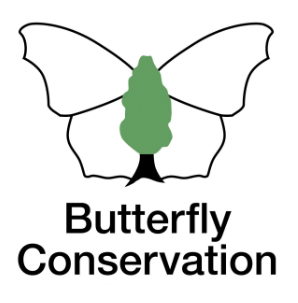Brown Argus
Brown Hairstreak
Chalkhill Blue
Clouded Yellow
Comma
Common Blue
Dark Green Fritillary
Dingy Skipper
Essex Skipper
Gatekeeper
Green Hairstreak
Green-veined White
Grizzled Skipper
Holly Blue
Large Skipper
Large White
Marbled White
Meadow Brown
Orange-tip
Painted Lady
Peacock
Purple Emperor
Purple Hairstreak
Red Admiral
Ringlet
Silver-washed Fritillary
Small Blue
Small Copper
Small Heath
Small Skipper
Small Tortoiseshell
Small White
Speckled Wood
Wall
White Admiral
White-letter Hairstreak
Extinct/rare immigrants
Green-veined White
Pieris napi
General Distribution and Status
This butterfly is very widespread and common in Britain and is the commonest 'white' in most of Scotland. It is not a garden pest and is more associated with wooded and damp areas than the other 'whites'. Habitat loss adversely affected the Green-veined White in the middle part of the 20th century and although the 1976 drought decimated colonies, numbers quickly built up again. In 1979 the species was exceptionally abundant in eastern England (Heath et al.). Generally, range and abundance since 1976 remained stable but numbers have dropped since 2015 with 2024 being the worst year on record. The situation in Hertfordshire and Middlesex is similar.
| United Kingdom | Herts & Middx | |||
| Distribution | 1976-2019 | -11% | 1980-2015 | +3% |
| Average 10-year trend | -2% | 2006-2015 | +19% | |
| 2024 since 2015-19 | +3% | |||
| Abundance | 1976-2024 | -28% | 1980-2015 | +2% |
| 2015-2024 | -37% | 2006-2015 | -24% | |
| 2023-2024 | -21% | 2024 since 2015-19 | -42% | |
UK distribution map
UKBMS Species summary
Habitat Requirements
The species is found in many habitats but prefers woodland edges, hedgerows and damp meadows. It is much scarcer on dry chalky soils.
Larval Foodplants
Garlic Mustard Alliaria petiolata, Hedge Mustard Sisymbrium officinale, Cuckooflower Cardamine pratensis in first brood, Watercress Nasturtium officinale, Horse Radish Armoracia rusticana, Rape Brassica napus and other Brassicaceae plants.
Adult Food Sources
Buddleia Buddleja davidii (255), Garden Lavender Lavandula x intermedia (137), Bramble Rubus fruticosus agg. (101), Creeping Thistle Cirsium arvense (89), Aubretia Aubretia deltoidea (86), Dandelion Taraxacum sp. (82).
Historical Records
Historical records dating back to Gibbs' time suggest that the Green-veined White was always a common butterfly in Hertfordshire although there is evidence of reduced numbers in the last century due to habitat destruction (Sawford).
Local Distribution and Abundance
The Green-veined White occurs in every tetrad as shown on the map. Numbers have declined dramatically since the mid-2000s. In 2004, 58 were counted at Knebworth Park by Ken King on 24 July but the highest counts were obtained in the Weston area in 1997 with 112 at Franklins Farm on 2 August and 100 at Cherrys Farm on 19 August. As already noted above, it is unknown why there is such a decline although numbers in 2018 bucked the long-term trend. 2024 was a relatively poor year with both spring and summer broods producing fewer specimens than usual.

Stevenage (South Fairlands Valley Park) transect 1993-2025
Unlike the rest of the Stevenage area 2009 proved to be an excellent year for the Green-veined White as well as in Hertfordshire as a whole but since that year there has been a notable decline although there was a notable pick-up in abundance in 2018. Although it is a regular visitor it is not as abundant as the other 'whites'; the most counted in any one week was 26 on 30 July 1994.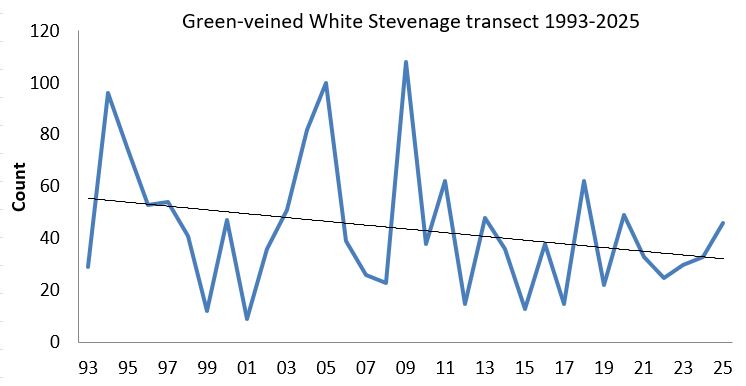

Knebworth Park transect 1996-2010 and 2017-2025
Abundance has dropped since the transect was resumed in 2017 although 2018 proved the best year for this species since 2004, bucking the downward trend.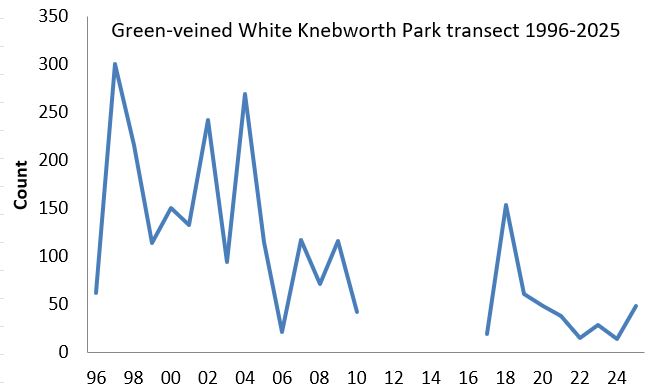
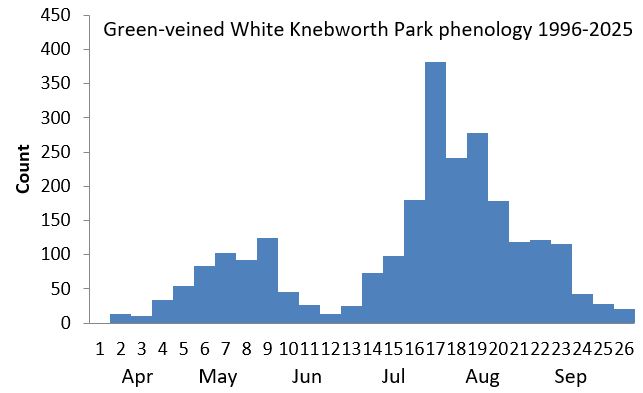
Knebworth Woods transect 2017-2025
Numbers continue to grow here with the majority seen in the lanes or tracks although drier conditions since 2020 may have impacted the development of the immature stages to produce fewer adults later in the year.
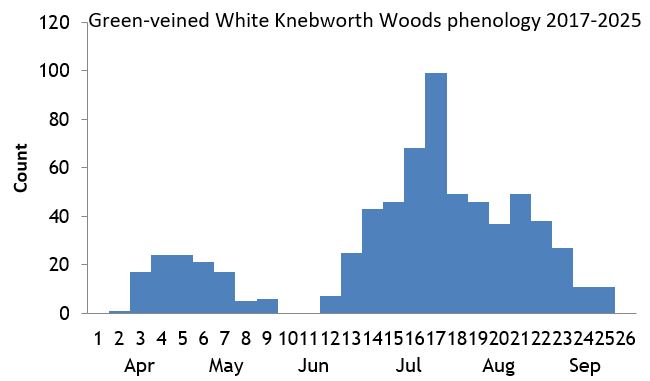
Pryor's Wood transect 2000-2022
Populations of this species are fairly stable although numbers are fairly low. The best year was 2003 when 51 specimens were counted including 23 on 10 August.Life History
Earliest date: 25 March 2011 near St Nicholas Church
Latest date: 30 September 2019 south of Watery Grove
The Green-veined White overwinters as
a pupa and emergence of the adults usually starts in April. The second generation is nearly always
greater than the first with the highest numbers often occurring in late July and early August. It has been known that some pupae from the first generation
stay in diapause until the following year. Small, fresh plants are selected for egg-laying on the underside of a leaf. Larvae feed on the leaves of the
foodplant. When fully-grown pupae are formed generally away from the foodplant close to the ground.
Behaviour/Observation notes
The Green-veined White is often seen in the same places in the wider countryside as the Small White although it is more common in the damp and sheltered areas. Its weak and fluttery flight helps to identify this butterfly on the wing to experienced observers but the best way to distinguish the two species is by markings on the wings especially on the undersides where the green veins are characteristic of this species. Pairings of this butterfly are more often observed than of the Small White in the wild in my experience.
Variations/Aberrations
The variations of the Green-veined White are extensive mostly to the ground colour and the dark spots on the wings. Specimens of the summer generation have
more dark marks on their uppersides compared to those flying in the spring. Cream-tinted individuals are not uncommon in the summer brood, known as the form
flava.
Find out more on the UK Butterflies website
References
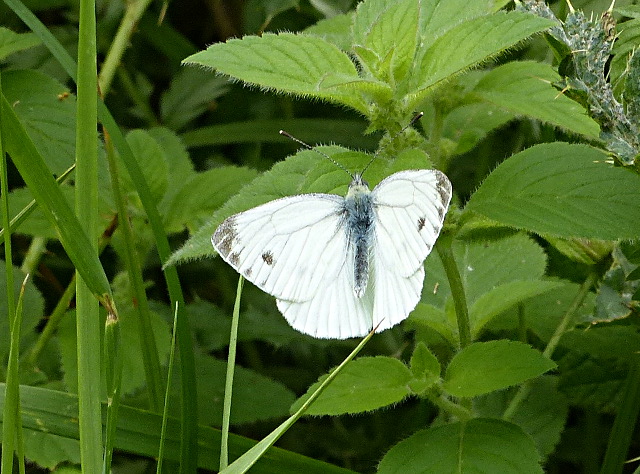
Watery Grove 15 Jul 2015 (m)
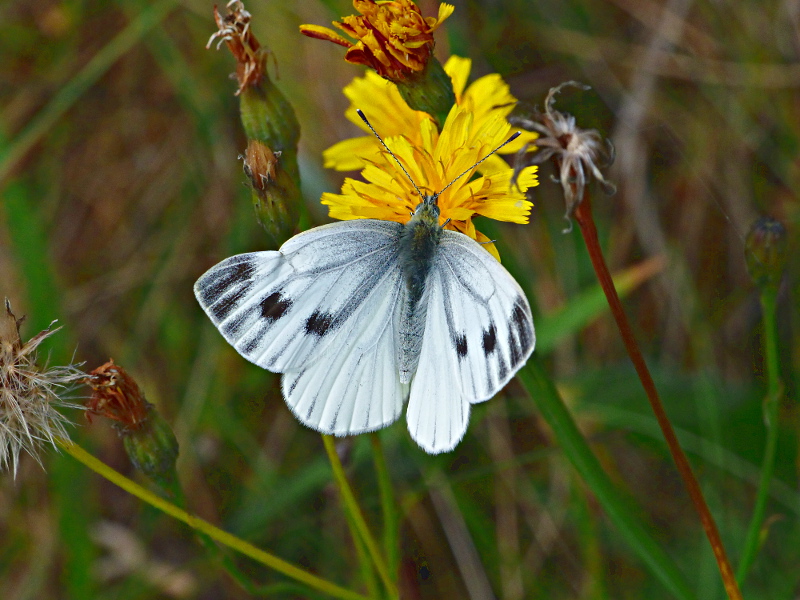
Fairlands Valley Park 10 Sep 2019
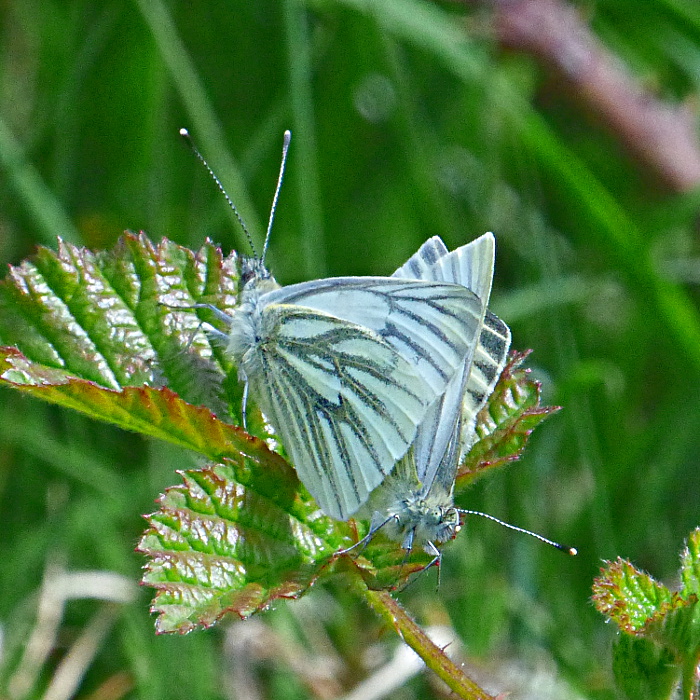
Fairlands Valley Park 18 Apr 2019
